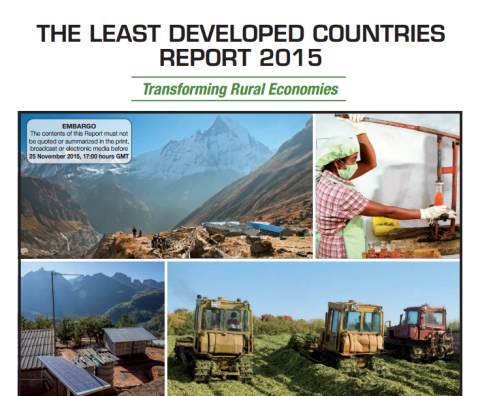The United Nations Conference on Trade and Development (UNCTAD) have recently launched their annual publication – ‘The Least Developed Countries Report 2015’ – which focuses on the theme of ‘Transforming rural economies’ this year. This report offers detailed socio-economic analysis of the complex issues that the world’s most impoverished countries, the Least Developed Countries (LDCs), face. The report explores the particularly problematic and catastrophic impacts on the most vulnerable and marginalised. Through this analysis, UNCTAD aims to present a new road map for transforming rural economies and eradicating rural poverty. If we are to achieve the ambitious sustainable development framework of Agenda 2030, we will have to directly target those most in need, particularly to realise the human rights to water and sanitation!
“… Typically, rural people in LDCs are 50 per cent more likely than their urban counterparts not to have access to sanitation or to attend secondary school, twice as likely not to have access to electricity or to attend primary school, and more than four times as likely not to have access to clean water. Achieving the SDGs would mean 45 per cent more rural children attending primary school and four times as many attending secondary school. It would also mean 70 per cent more rural people having access to an improved water source, 250 per cent more to sanitation, and 10 times as many to electricity. This would require a quantum leap in infrastructure investment in rural areas of LDCs: Access to water needs to increase more than twice as fast as in 2011–2012, access to electricity four times as fast and sanitation six times as fast. …
The present human rights framework places responsibility for the “progressive realization” of economic and social rights on national Governments — which are supposed to act within the means available to them — alongside the international dimension. The Sustainable Development Goals (SDGs), by contrast, represent two fundamental changes as compared with the existing framework. They constitute an acceptance by the global community as a whole of collective responsibility for the achievement of economic and social rights by the world population as a whole. They also set a date for the realization of these rights (2030). These two shifts are mutually interdependent: Collective responsibility provides the means of overcoming national resource constraints within the given time frame. The absolute nature of the SDGs — eradicating human development shortfalls rather than merely reducing them — has critically important implications. First, it requires an enormous acceleration in the rate of progress: recent estimates suggest that the “global consumption floor” (in principle, the consumption per capita of the poorest household in the world) has stagnated for 20–30 years, but must double in the next 15 years if poverty is to be eradicated. Second, it implies a fundamental shift in focus, towards areas of greatest need. This, in effect, means the least developed countries, because this is where poverty is systematically highest, where it is falling most slowly and where the obstacles are greatest. The LDCs are, quite simply, the battleground on which the 2030 Agenda for Sustainable Development will be won or lost.”
We have to stop inherent systemic inequalities if we are to see the change we want in the world and achieve the Global Goals! Download the report today.

All previous reports from the past few years are also available online on the UNCTAD website.